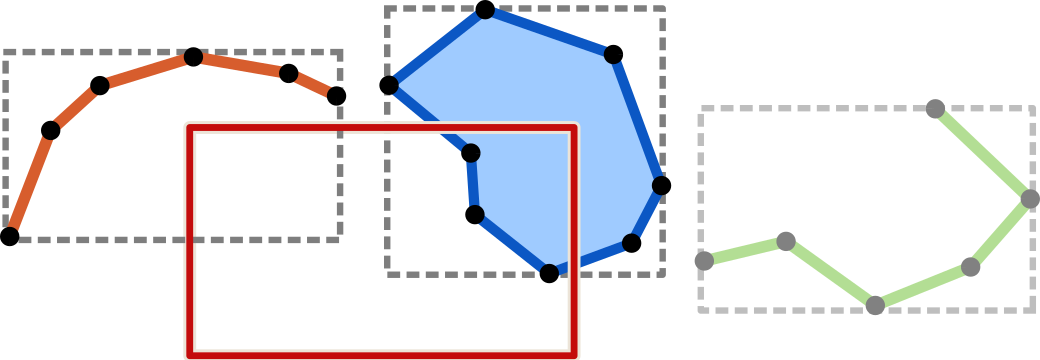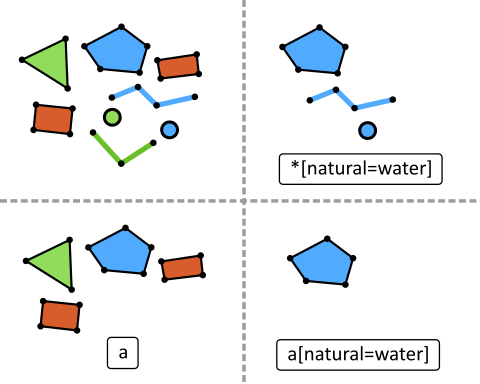Queries and Feature Collections
Geospatial applications typically work with subsets of features in a library, such as buildings in a town, or waterways in a particular region. These subsets are represented as feature collections, which are the result of queries.
Feature collections are lightweight objects that merely described what should be returned; they don’t actually contain any objects and take up minimal space. In other words, query execution is lazy: Features are fetched only once they are needed, in response to iteration or a call to
count().Feature collections can be ordered or unordered. Only the nodes of a way and the members of a relation are ordered; all other query results are returned in arbitrary order.
Start working with collections by creating a root collection, which contains all features in a given Geographic Object Library:
Features(const char* golFileName);
From this collection, you can create others:
Features france("path/to/france.gol");
...
Features shops = france("na[shop]");
Features thingsInParis = france(paris); // Feature or geometry
Features shopsInParis = shops & thingsInParis;
Filtering features
To select a subset of Features, add the constraint in parentheses, or apply a filter method. This always creates a new collection, leaving the original Features object unmodified.
By bounding box
Select the features whose bounding boxes intersect the given Box:

Features france("france.gol");
Box parisBounds = Box::ofWSEN(
2.2, 48.8, 2.5, 48.9);
Features thingsInParis = france(parisBounds);
By type and tags
Apply a query written in GOQL (Geographic Object Query Language) to select features based on their type and tags:

Features restaurants = world(
"na[amenity=restaurant]");
// nodes and areas
Nodes fireHydrants = world(
"n[emergency=fire_hydrant]");
// only nodes
Ways safeForCycling = world(
"w[highway=cycleway,path,living_street],"
"w[highway][maxspeed < 30]");
// linear ways
Using filter methods
Apply a spatial filter or topological filter, or a custom filter:
states.within(usa)
features("w[highway]").membersOf(route66)
parks.filter(MyFilters::containsWaterFountains);
Using set intersection
Select only features that are in both sets:
Features museums = world("na[tourism=museum]");
Features inParis = world.within(paris);
Features parisMuseums = museums(inParis);
Alternatively, you can use the & operator:
Features parisMuseums = museums & inParis;
Obtaining Feature objects
Simply iterate:
for(Feature hotel : hotels)
{
std::cout << hotel["name"] << std::endl;
}
Create a std::vector, or populate an existing one:
std::vector<Feature> list = streets;
streets.addTo(myVector);
Check if the set is empty:
if (pubs.within(dublin))
printf("Great, we can grab a beer in this town!");
if (!street.nodes("[traffic_calming=bump]"))
printf("No speed bumps on this street.");
Obtaining a single Feature
first
Returns the first feature in a collection:
std::optional<Feature> city = france("n[place=city][name=Paris]").first();
Note that only the nodes of ways and members of relations are ordered collections; all others are unordered sets, which means you’ll receive a random feature if there are more than one. If the collection is empty, first() returns nullopt.
one
Returns the one and only feature of the collection. Throws a QueryException if the collection is empty or contains more than one feature.
Feature paris = world("n[place=city][name=Paris]").one();
// will likely throw a QueryException,
// because there's also Paris, Texas
Testing for membership
To check if a feature belongs to a given set, use contains():
Features sushiRestaurants =
world("na[amenity=restaurant][cuisine=sushi]");
if (sushiRestaurants.contains(restaurant))
std::cout << restaurant["name"] << " serves sushi";
Scalar queries
count
The total number of features in the collection:
printf("%d restaurants found.", restaurants.count());
area
The total area (square meters as double) of all areas in this set.
printf("London has %f square meters of parks.",
parks.within(london).area());
length
The total length (meters as double) of all features in this set. For areas, their circumference is used.
printf("The French motorway network is %f km long.",
france("w[highway=motorway]").length() / 1000);
Spatial filters
Features can be filtered by their spatial relationship to other geometric objects (typically a GEOSGeometry or another Feature).
containing
Selects features whose geometry contains A:
- Every point of A is a point of the candidate feature, and the interiors of the two geometries have at least one point in common.
Features containing(Feature);
Features containing(GEOSContextHandle_t, const GEOSGeometry*);
Features containingXY(Coordinate);
Features containingLonLat(double, double);
For example:
// In which park (if any) is this statue of Claude Monet?
return features("a[leisure=park]")
.containing(statueOfMonet).first();
// The county, state and country for this point -- should return
// San Diego County, California, USA (in no particular order)
return features("a[boundary=administrative][admin_level <= 6]")
.containingLonLat(-117.25, 32.99);
crossing
Selects features whose geometry crosses A:
- The geometries of A and the candidate feature have some (but not all) interior points in common
- The dimension of the intersection must be less than the maximum dimension of the candidate and A.
Features crossing(Feature);
Features crossing(GEOSContextHandle_t, const GEOSGeometry*);
For example:
// All railway bridges across the Mississippi River
Features railwayBridges = features("w[railway][bridge]");
return railwayBridges.crossing(mississippi);
intersecting
Selects features whose geometry intersects A:
- The geometries of A and the candidate feature have at least one point in common.
Features intersecting(Feature);
Features intersecting(GEOSContextHandle_t, const GEOSGeometry*);
maxMetersFrom
Selects features whose distance to A is less or equal to m meters (measured between the closest points of the candidate feature and A).
Features maxMetersFrom(double, Coordinate);
Features maxMetersFromLonLat(double, double, double);
For example:
// All bus stops within 500 meters of the given restaurant
Features nearbyBusStops = features("n[highway=bus_stop]")
.maxMetersFrom(500, restaurant);
// All features within 3 km of the given point
return features.maxMetersFromLonLat(3000, 76.41, 40.12);
within
Selects features that lie entirely within A:
- Every point of the candidate feature is a point in A, and their interiors have at least one point in common.
Features within(Feature);
Features within(GEOSContextHandle_t, const GEOSGeometry*);
Topological filters
These methods return a subset of those features that have a specific topological relationship with another Feature.
nodesOf
The nodes of the given way. Returns an empty set if the feature is a Node or Relation.
Nodes nodesOf(Feature);
membersOf
Features that are members of the given relation, or nodes of the given way. Returns an empty set if the feature is a Node.
Features membersOf(Feature);
parentsOf
Relations that have the given feature as a member, as well as ways to which the given node belongs.
Features parentsOf(Feature);
Custom filters
Use filter() with your own filter predicate:
// Find all parks whose area is at least 1 km²
// (one million square meters)
Features parks = world("a[leisure=park]");
Features largeParks = parks.filter([](Feature park)
{ return park.area() > 1'000'000; });
Important: The predicate must be threadsafe, as the query may be executed in parallel.